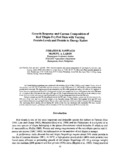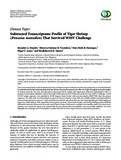Growth response and carcass composition of red tilapia fry fed diets with varying protein levels and protein to energy ratios
- Global styles
- MLA
- Vancouver
- Elsevier - Harvard
- APA
- Help
Share
Abstract
An 8-week feeding experiment was conducted with red tilapia (Oreochromis ) fry of 0.160 plus or minus 0.035 g initial weight. Twelve diets of 4 protein levels (25, 30, 35 and 40%) and 3 protein to energy (P/E) ratios (111, 100 and 80 mg protein/kcal) at each protein level were used. The highest growth was attained by fry fed a 40% protein diet with a P/E ratio of 111 mg/kcal. A lower but not a significantly different growth response was attained by fry on a 35% protein diet with a P/E ratio of 111 mg/kcal and a 30% protein diet with a P/E ratio of 100. Protein efficiency ratio was affected by the dietary protein level. Feed conversion ratio was not significantly influenced by the dietary protein level nor the P/E ratio. Carcass moisture content (%) was affected only by the P/E ratio. Carcass moisture content was directly related to the P/E ratio of the diets and was inversely related to the digestible energy (DE) level. Both protein level and P/E ratio significantly influenced carcass lipid content (%) on a dry matter basis but not the ash content. Carcass lipid (5) increased with increasing dietary protein and increasing DE levels of the diet, but decreased with increasing P/E ratio. Carcass protein content decreased significantly with the decrease of P/E ratio and increase of DE level of the diet.
Suggested Citation
Santiago, C. B., & Laron, M. A. (1991). Growth response and carcass composition of red tilapia fry fed diets with varying protein levels and protein to energy ratios. In S. S. De Silva (Ed.), Fish Nutrition Research in Asia. Proceedings of the Fourth Asian Fish Nutrition Workshop, 3-8 September 1990, Vijayawada, Andhra Pradesh, India (pp. 55–62). Manila, Philippines: Asian Fisheries Society.
Type
Conference paperCollections
- Conference Proceedings [299]
Related items
Showing items related by title, author, creator and subject.
-
Evaluation of fish protein concentrate and lactic yeast as protein sources for shrimp feeds
Millamena, O.M.; Triño, A.V. (Asian Fisheries Society, 1994)Protein sources, hydrolyzed fish protein concentrate and plasmolyzed lactic yeast, were used to partially replace fish meal and soybean meal, respectively, in a basal diet (diet 1) at these levels; 5% fish protein concentrate ... -
Earthworm, marine annelids and squid as feed ingredients in formulated diets for juvenile Penaeus monodon
Pascual, F.P. (Aquaculture Department, Southeast Asian Fisheries Development Center, 1985)Earthworm and annelids were incorporated in diets for Penaeus monodon juveniles (mean weight 0.54 g) either in wet or dry form. These protein sources were added in amounts needed to replace 10% of the animal source of ... -
Subtracted transcriptome profile of tiger shrimp (Penaeus monodon) that survived WSSV challenge
Maralit, Benedict A.; Ventolero, Minerva Fatimae H.; Maningas, Mary Beth B.; Amar, Edgar C. ; Santos, Mudjekeewis D. (Hindawi Publishing Corporation, 2014)
There is increased interest in the development of virus-resistant or improved shrimp stock because production is currently hindered by outbreaks and limited understanding of shrimp defense. Recent advancement now allows ...
; Santos, Mudjekeewis D. (Hindawi Publishing Corporation, 2014)
There is increased interest in the development of virus-resistant or improved shrimp stock because production is currently hindered by outbreaks and limited understanding of shrimp defense. Recent advancement now allows ...





